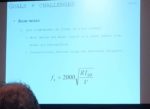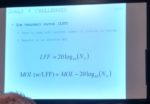Notes from Day 3 of the 143rd AES convention in New York City.
This was my last day, though there were more sessions on Saturday I was headed out of the city.
Started off with some papers from P12 – Transducers—Part 3. At this point the session names and the titles aren’t all that correlated. P12-1 Objective Testing of High-End Audio Systems provided a reasonable overview of testing but I don’t think a lot of new insights. Next up was P12-2 Theory of Constant Directivity Circular-Arc Line Arrays. Had met Don Keele at CES where he was demoing the latest CBT in the Parts Express suite. What’s interesting is how Don’s intuition about what might work is now backed up by some solid analysis.
- CBT theory
- CBT theory
 Next up was DSP Concepts’ Paul Beckman discussing fast development (oh, wait, Agile is the correct buzzword) using block based tools. Having developed a product 20 years ago to do the same it was nice to see the idea had merit. The demos added a lot of value, making this one of the better presentations.
Next up was DSP Concepts’ Paul Beckman discussing fast development (oh, wait, Agile is the correct buzzword) using block based tools. Having developed a product 20 years ago to do the same it was nice to see the idea had merit. The demos added a lot of value, making this one of the better presentations.
The scarcity of people with audio+embedded+DSP skills was written up in EETimes. Need a high end linked in account though to get the analytics accesses to replicate this so I take 11 people with a grain of salt.
A live sound session was looking at subwoofer placement. While a home listening room is a way different application the end goals are the same and was curious to see what practical advice might be offered. Wish I had the full deck to remember the context of the two I captured to remind me about this.
Another well attended DSPConcepts presentation, this time on voice interfaces, was interesting with a lot of data about effect of SNR on recognition accuracy (better than – 10 dB and you’re pretty good), number of mics on performance (5 is good), and practical system design. Again some live demos made the points clear. Also a nice reminder that not all audio has to be about film or music.
 Last session of the show for me was SA10 – Native Immersive Recordings. This was mostly about recording live-performed materials so no object audio would be present – I assume studio made pieces – particularly EDM, techno, etc., might use objects for special effects. But so far it seems like volume panning and fixed speaker locations dominates on the music side (but don’t quote me on that as I didn’t get to a wide enough range of sessions). There’s an implication for home systems where the recording puts the listener is the center is that content can came from any speaker (though less from overheads) so the bed channels would want to be all same speaker and power rating. OTOH recordings where the performers are in front of the listener would be like movie audio, with must sound from the front.
Last session of the show for me was SA10 – Native Immersive Recordings. This was mostly about recording live-performed materials so no object audio would be present – I assume studio made pieces – particularly EDM, techno, etc., might use objects for special effects. But so far it seems like volume panning and fixed speaker locations dominates on the music side (but don’t quote me on that as I didn’t get to a wide enough range of sessions). There’s an implication for home systems where the recording puts the listener is the center is that content can came from any speaker (though less from overheads) so the bed channels would want to be all same speaker and power rating. OTOH recordings where the performers are in front of the listener would be like movie audio, with must sound from the front.
Friday night: This was like a great place to go: http://bohemianhall.com/ After an hour of two of trying to ignore all the smells coming from the grill gave in and got food…






